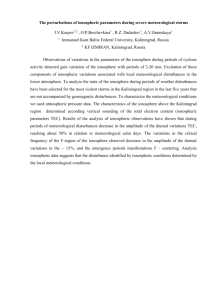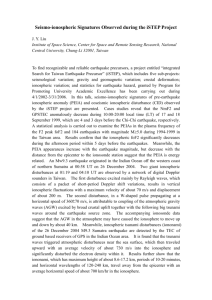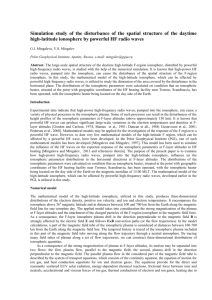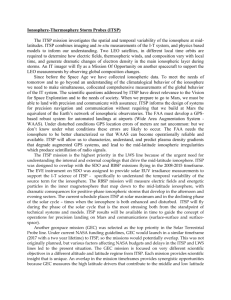Microsoft Word
advertisement
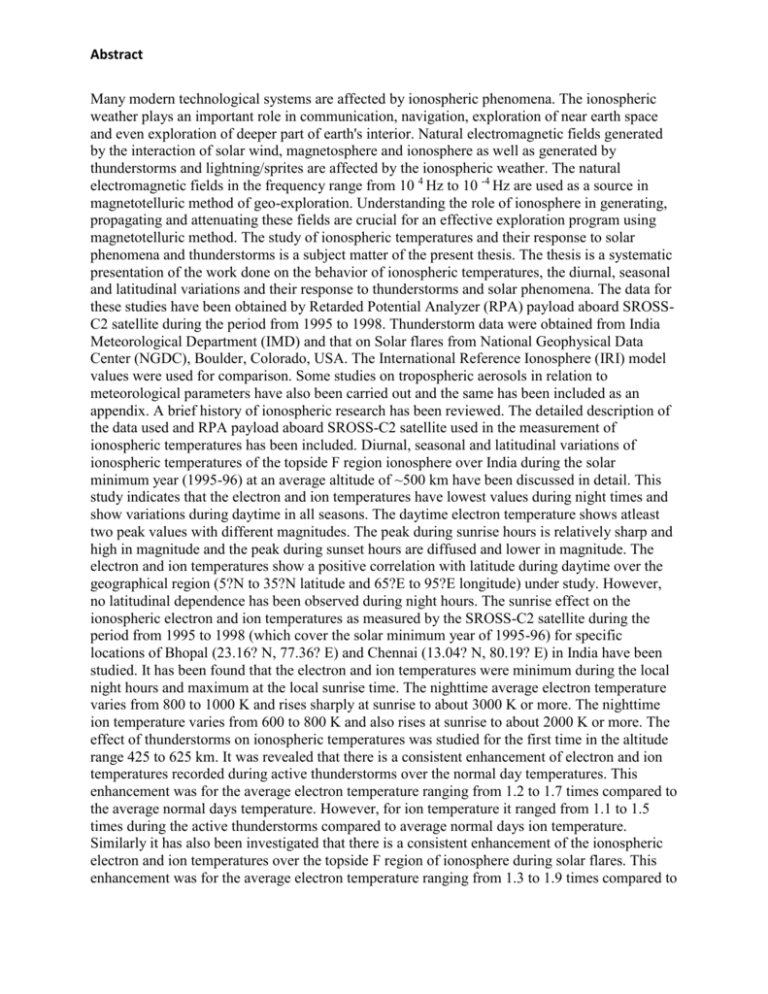
Abstract Many modern technological systems are affected by ionospheric phenomena. The ionospheric weather plays an important role in communication, navigation, exploration of near earth space and even exploration of deeper part of earth's interior. Natural electromagnetic fields generated by the interaction of solar wind, magnetosphere and ionosphere as well as generated by thunderstorms and lightning/sprites are affected by the ionospheric weather. The natural electromagnetic fields in the frequency range from 10 4 Hz to 10 -4 Hz are used as a source in magnetotelluric method of geo-exploration. Understanding the role of ionosphere in generating, propagating and attenuating these fields are crucial for an effective exploration program using magnetotelluric method. The study of ionospheric temperatures and their response to solar phenomena and thunderstorms is a subject matter of the present thesis. The thesis is a systematic presentation of the work done on the behavior of ionospheric temperatures, the diurnal, seasonal and latitudinal variations and their response to thunderstorms and solar phenomena. The data for these studies have been obtained by Retarded Potential Analyzer (RPA) payload aboard SROSSC2 satellite during the period from 1995 to 1998. Thunderstorm data were obtained from India Meteorological Department (IMD) and that on Solar flares from National Geophysical Data Center (NGDC), Boulder, Colorado, USA. The International Reference Ionosphere (IRI) model values were used for comparison. Some studies on tropospheric aerosols in relation to meteorological parameters have also been carried out and the same has been included as an appendix. A brief history of ionospheric research has been reviewed. The detailed description of the data used and RPA payload aboard SROSS-C2 satellite used in the measurement of ionospheric temperatures has been included. Diurnal, seasonal and latitudinal variations of ionospheric temperatures of the topside F region ionosphere over India during the solar minimum year (1995-96) at an average altitude of ~500 km have been discussed in detail. This study indicates that the electron and ion temperatures have lowest values during night times and show variations during daytime in all seasons. The daytime electron temperature shows atleast two peak values with different magnitudes. The peak during sunrise hours is relatively sharp and high in magnitude and the peak during sunset hours are diffused and lower in magnitude. The electron and ion temperatures show a positive correlation with latitude during daytime over the geographical region (5?N to 35?N latitude and 65?E to 95?E longitude) under study. However, no latitudinal dependence has been observed during night hours. The sunrise effect on the ionospheric electron and ion temperatures as measured by the SROSS-C2 satellite during the period from 1995 to 1998 (which cover the solar minimum year of 1995-96) for specific locations of Bhopal (23.16? N, 77.36? E) and Chennai (13.04? N, 80.19? E) in India have been studied. It has been found that the electron and ion temperatures were minimum during the local night hours and maximum at the local sunrise time. The nighttime average electron temperature varies from 800 to 1000 K and rises sharply at sunrise to about 3000 K or more. The nighttime ion temperature varies from 600 to 800 K and also rises at sunrise to about 2000 K or more. The effect of thunderstorms on ionospheric temperatures was studied for the first time in the altitude range 425 to 625 km. It was revealed that there is a consistent enhancement of electron and ion temperatures recorded during active thunderstorms over the normal day temperatures. This enhancement was for the average electron temperature ranging from 1.2 to 1.7 times compared to the average normal days temperature. However, for ion temperature it ranged from 1.1 to 1.5 times during the active thunderstorms compared to average normal days ion temperature. Similarly it has also been investigated that there is a consistent enhancement of the ionospheric electron and ion temperatures over the topside F region of ionosphere during solar flares. This enhancement was for the average electron temperature ranging from 1.3 to 1.9 times compared to Abstract the normal days average temperature. However, for ion temperature it was 1.2 to 1.4 times to the normal days average temperature. The effect of solar flare on the nightside ionospheric temperatures has not been detected in the altitude range from 425 to 625 km. The studies on aerosol generation, distribution and different mechanisms involved in aerosol formation during the summer session (April-July, 1999) at Roorkee were done. Their relation to meteorological parameters has also been carried out. The studies indicate that the large size aerosols are specially sensitive to variations in meteorological parameters. The relative humidity, temperature, rainfall and wind speed play an important role to modulate the aerosol behavior. The large amount of precipitation can alter the number density and size distribution of atmospheric aerosols more efficiently than the relative humidity and wind speed.
